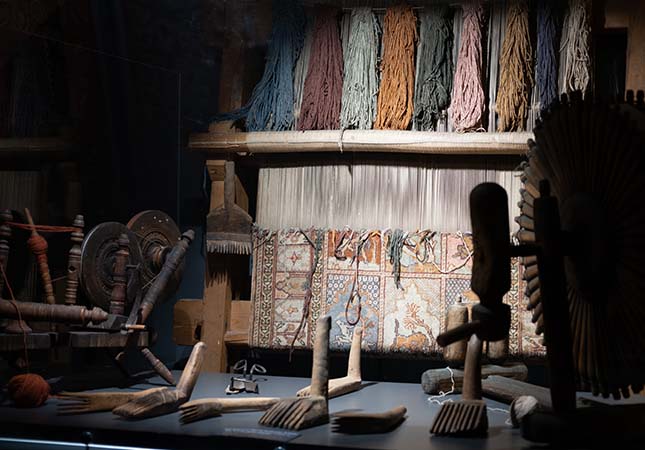India primarily employs the floor loom as its predominant weaving apparatus. This kind of loom machine is usually crafted from wood, with the framework being an exception as it is commonly made of metal. The warp threads are stretched across the frame and secured with heddles, which are affixed to a shaft capable of being raised or lowered to manipulate the shed's opening and closing. To produce the fabric, the weft thread is then passed through the shed using a shuttle.

Although floor looms are widely utilized in India, there are also handlooms available. Handlooms are smaller in size and portable, making them well-suited for domestic or small-scale businesses. Unlike floor looms, handlooms utilize a pit contacts system rather than heddles to manipulate the shed, simplifying the weaving process.
In recent times, there has been a resurgence of interest in traditional Indian fabrics and techniques. As a result, a new generation of weavers has emerged, dedicated to reviving forgotten methods and developing innovative designs.
Historical Overview of Weaving Loom Machine Development
In India, the initial weaving looms were modest and handheld, enabling the production of a limited amount of fabric. These early looms likely served the purpose of household production, with historical evidence pointing to the involvement of women and children in this craft. As trade flourished between India and other regions, the demand for Indian textiles soared, prompting the evolution of more advanced weaving looms capable of generating larger quantities of fabric.
The most noteworthy advancements in Indian weaving loom technology transpired during the Mughal period. The Mughals introduced fresh designs and techniques from Persia and Central Asia, significantly enhancing the efficiency and quality of Indian textile manufacturing. Notably, the integration of foot pedals revolutionized the weaving process, empowering weavers to operate the looms with both hands and thereby amplifying their productivity.
During the Mughal era, professional weavers emerged, operating within expansive workshops known as charkhas. These workshops were typically supervised by a master weaver who oversaw the efforts of numerous apprentices. The growing specialization and systematic organization of labor facilitated the production of intricate patterns and designs that held immense value among consumers.
Subsequent to the Mughal Empire's decline in the 18th century, Indian weaving experienced a period of regression. The introduction of British textiles into India undercut local producers, leading to a diminished demand for Indian fabrics. However, in the late 19th century, there was a remarkable resurgence of interest in traditional Indian textiles.
Traditional Looms in Different Regions of India
India boasts a rich and extensive history of textile production, with the loom playing a pivotal role in shaping this industry. Across different regions of India, one can find a diverse array of traditional looms, each distinguished by its unique characteristics.
The frame loom stands as the simplest type, prevalent throughout various parts of the country. This loom is specifically employed for crafting narrow fabrics like ribbons and sashes. Its construction involves a frame upon which the warp threads are tautly stretched. By employing a shuttle, the weft is interwoven, and the fabric gradually takes shape through the shuttle's back-and-forth movement amidst the warp threads.
Another widely encountered loom in India is the pit loom, resembling the frame loom but situated within a pit excavated in the ground. This type of loom is often utilized for weaving larger fabric pieces such as shawls and blankets. Seated on one side of the pit, the weaver extends the warp threads to the opposite side. Inserting the weft with a shuttle or another instrument, they deftly weave the fabric by maneuvering the shuttle rhythmically amidst the warp threads.
The treadle loom constitutes yet another prevalent loom variant in India, similar to the frame loom but distinguished by a pedal that governs the shuttle's movement.
Contemporary Weaving Looms in India
Weaving looms have been an integral part of Indian craftsmanship for centuries, with techniques and designs passed down through generations. In the present day, a wide range of weaving looms with distinct features are found across India.
The handloom reigns as the most widespread type of weaving loom, operated manually by skillful weavers who deftly pass the thread back and forth over the warp threads using a shuttle. Handlooms are primarily employed for smaller projects like scarves or table runners.
Additionally, the pit loom remains a popular choice, similar to handlooms but larger in size, allowing two or more individuals to work together. These looms are commonly utilized for larger projects, including blankets and rugs.
There is a growing prevalence of power looms in India as well. These automated machines enable rapid fabric weaving, surpassing the speed of handlooms and pit looms, thus making them ideal for mass production. However, due to their substantial cost for purchase and operation, power looms are typically employed by larger businesses or factories.
SUNTECH Textile Machinery has the range of products encompasses almost all fabric types, including but not limited to pinking machine, loom machine, weaving machine, beam truck, fabric cutting machine, motorized beam trolley, beam storage, and fabric inspection machine. SUNTECH Textile Machinery continues to lead the textile industry with its innovative approach and extensive experience. We welcomes quotes and cooperation opportunities with open arms.




